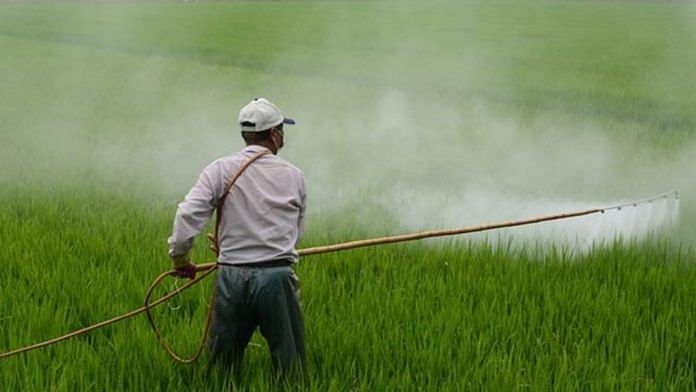
Thank you dear subscribers, we are overwhelmed with your response.
Your Turn is a unique section from ThePrint featuring points of view from its subscribers. If you are a subscriber, have a point of view, please send it to us. If not, do subscribe here: https://theprint.in/subscribe/
As per the annual report published by the Ministry of Agriculture & Farmers Welfare, Government of India, the estimated food grain production in 2022 was 315.72 million tonnes, which is the highest ever food grain production. This achievement is largely attributed to modern farming techniques, better seeds, farmers’ education programs, government policies, and the use of fertilizers and pesticides.
Since the green revolution, pesticides have played an important role in the production of food grains. Although, there is a recent trend towards organic farming. However, until December 2022, only 6.53 lakh hectare of land was covered under organic farming, which constitutes about 2.45% of the total farming land.
In India, a total of 318 pesticides (as of 01 October 2022) are registered for use. According to Statista, during the fiscal year 2022, the pesticide production volume amounted to 299 thousand metric tons across India. Many of these registered pesticides fall under the hazardous category defined by WHO and have already been banned in other countries. Only around 2% of the pesticides used in India are listed in the category of WHO class U (unlikely to cause any hazard) and another 2% are registered as non-toxic on the PAN international database.
Pesticides are well known to cause harmful effects on soil, air, water, food, and public health. Numerous studies are available that shows the effect of pesticides on farmers health, role in Parkinson disease, consumers including pregnant mothers and infants, and other non-target wildlife. Therefore, from time to time, governments create expert panels to review the toxic effects of these chemicals and recommend to banning or restricting their use. In May 2020, the Indian government banned 27 pesticides considered hazardous to public health and safety. However, in February 2023, the Centre modified the ban order, removing 24 of the 27 pesticides from the list.
These recommendations have raised questions about the review process followed by decision-makers and sparked a debate between industry experts, environmentalists, and other related stakeholders.
Although pesticides are an integral part of sustained food grain production, public health and the environment are of more importance than ever. Therefore, we need to rethink our strategies against pesticides and find a win-win situation with heightened collaboration between all stakeholders, including manufacturers, dealers, farmers, government agencies, scientists, and environmentalists.
First of all, we need to avoid reinventing the wheel and learn from research conducted in other parts of the world against hazardous pesticides. We must review the reasons behind decisions taken by foreign countries to limit their use and apply that knowledge while considering our ground reality.
Second, while manufacturers have their own justifications for the use of pesticides, they cannot ignore their responsibilities towards the environment and should be held accountable. Similar to a carbon tax, there is a need for a hazardous pesticide tax against manufacturers. The magnitude of the tax could be based on the magnitude of negative impact of pesticide they are manufacturing on public health and environment. This tax fund could be used to conduct further research to mitigate the harmful effects and find alternate sustainable technologies.
Third, dealers and farmers are equally responsible for the use of harmful pesticides. The overuse of pesticides is one of the biggest reasons for their harmful effects on the environment and public health. Therefore, there is a need to control the use of pesticides and have an approach similar to prescription and over-the-counter drugs. This could be regulated through schemes similar to ration cards & soil health cards, where farmers receive a quantity of pesticide based on their land area, the health of the soil and crop type. A target must be set for dealers to sell biopesticides and other safer alternatives based on a percentage of their total sales volume.
Finally, the government and research organizations need to collaborate to find more affordable ways to test for pesticide contamination in food chain. The price of food grain could be based on the level of contamination found in the grains, which would discourage farmers from overusing pesticides and encourage them to adopt natural farming methods. It is important to rethink our current approach and adopt bold strategies that may seem daunting in the short run, but will have long-term benefits for public health, the environment, and farmers.
These pieces are being published as they have been received – they have not been edited/fact-checked by ThePrint.

COMMENTS